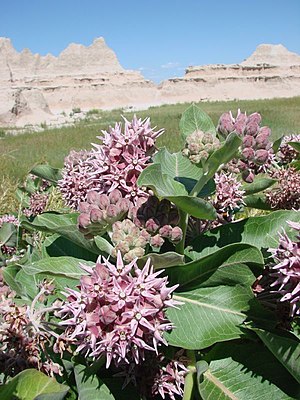Asclepias speciosa
| Asclepias speciosa | ||||||||||||
|---|---|---|---|---|---|---|---|---|---|---|---|---|

Asclepias speciosa |
||||||||||||
| Systematics | ||||||||||||
|
||||||||||||
| Scientific name | ||||||||||||
| Asclepias speciosa | ||||||||||||
| Torr. |
Asclepias speciosa , rarely also called beautiful milkweed , is a species of the genus silk plants ( Asclepias ) from the subfamily of the silk plants (Asclepiadoideae).
description
Vegetative characteristics
Asclepias speciosa grows as a perennial herbaceous plant and reaches heights of 60 to 100 centimeters. The above-ground parts of the plant are hairy ( trichomes ). The ascending to upright, firm, unbranched stems are generally dense, white, woolly to downy hairy.
The leaves are arranged opposite one another on the stem. The short petioles are 0.5 to 1.5 cm long. The simple leaf blade is with a length of 6 to 20 cm and a width of 3 to 14 cm elliptical to ovate or oblong-ovoid to ovate-lanceolate with a very broadly rounded and occasionally weakly heart-shaped blade base and usually broadly oval-rounded, rarely also pointed The End. The firm-skinned leaf blades are densely white on the underside, with downy hairs and glabrous on the upper side.
Generative characteristics
The flowering period extends from May to September. The few or many flowers are grouped together in a dold-like inflorescence , which is laterally and individually formed on some of the upper nodes. The sturdy inflorescence stem is 1 to 10 cm long and densely white, with downy hairs. The flower stalks have a length of 2 to 3 cm.
The relatively large, striking flowers are hermaphroditic, radial symmetry and five-fold. The flower colors range from light purple to pink. The five white, downy hairy sepals are lanceolate with a length of 5 to 6 mm. The five shovel-shaped and far back-bent petals are 10 to 15 mm long. The gynostegium has a light pink to almost whitish, short stalk that is only about 1 mm long and 3 mm thick. The staminal corolla lobes are relatively long with 10 to 14 mm, lanceolate and widely spread. The edges are curved upwards, more or less tubular at the base and decreasing towards the tip. The interstaminal corolla lobes are horn-shaped or sickle-shaped and bent sharply inward and significantly shorter than the staminal corolla lobes. The stylus head is truncated conical, about 3 mm high and 4.5 mm thick.
The upright according to bent down stems follicles are pointed with a length of 11 to 13 cm and a diameter of 2 to 3 cm thick to thin spindle-shaped and abruptly or rather slow wedge-shaped. The outside is smooth to densely covered with fine thorns and fine, white, downy hairy. With a length of 6 to 9 mm, the oval seeds have a 3 to 4 cm long, white head of hair.
Occurrence
The distribution area of Asclepias speciosa extends from British Columbia to central Canada and California as well as Texas . Asclepias speciosa occurs in mountain meadows, in sparse forests and along rivers, also in cultivated land. It grows widespread on roadsides and along railway lines. Asclepias speciosa thrives at altitudes between 1500 and 2600 meters.
Systematics
The first description of Asclepias speciosa was made in 1827 by John Torrey in Annals of the Lyceum of Natural History of New York , 2, pp 218-219. Synonyms for Asclepias speciosa Torr. are: Asclepias douglasii Hook. and Asclepias giffordii Eastw.
swell
literature
- Robert E. Woodson, Jr .: The North American Species of Asclepias L. , In: Annals of the Missouri Botanical Garden , 41 (1), St. Louis, Mo., 1954, pp. 1-211: URL (description of A. speciosa on pp. 124–126)
- Eric Sundell: Asclepiadaceae Milkweed Family , In: Journal of the Arizona-Nevada Academy of Science , 27 (2), 1993, pp. 169-187: PDF; 339 kB)
- James C. Hickman (Ed.): The Jepson Manual. Higher Plants of California . University of California Press, Berkeley, Calif 1993, ISBN 0-520-08255-9 . Asclepias speciosa - Carol A. Hoffman: Asclepiadaceae in Jepson Manual Treatment - Online. (Section Description and Distribution)
Individual evidence
- ↑ Asclepias speciosa (Beautiful milkweed)
- ^ Asclepias speciosa at Tropicos.org. Missouri Botanical Garden, St. Louis

